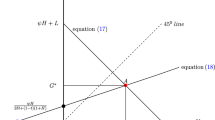Abstract
A central issue in the analysis of public goods is the relationship between the optimal provision level and the distribution of income. Theoretical research has stressed the conditions under which the optimum is independent of the distribution of income. Here we focus on numerical analysis of more policy-relevant concerns. Specifically, to what extent is a given redistribution of income likely to affect the optimal level of public good supply? And how significant are the welfare costs of not adjusting public good supply when income distribution changes? We use an applied general equilibrium (AGE) model of the Australian economy and public sector to generate numerical estimates of the impacts of redistributive policies on these variables. Results suggest that the traditional separation of allocation and distribution in determining the level of public good supply may be a justifiable empirical simplification, except where very dramatic redistributions are involved.
Similar content being viewed by others
References
Atkinson A B, Stern N H (1974). “Pigou, Taxation and Public Goods”. Review of Economic Studies, 41, January: 119–128
Bergstrom T C, Cornes R (1983). “Independence of Allocative Efficiency from Distribution in the Theory of Public Goods”. Econometrica, 51, 6: 1753–1766
Bergstrom T C, Goodman R P (1973). “Private Demands for Public Goods”. American Economic Review, 63: 280–296
Foley D (1970) “Lindahl's Solution and the Core of an Economy with Public Goods”. Econometrica, 38: 1, 66–72
Gorman W M (1953). “Community Preference Fields”. Econometrica, 21: 63–80
Mansur A, Whalley J (1984). “Numerical Specification of Applied General Equilibrium Models” in Scarf H E, Shoven J (eds) Applied General Equilibrium Analysis. Cambridge University Press, New York
Piggott J (1983) “A Walrasian Model of the Australian Economy and Public Sector: Specification Procedures and Data Set Construction”. Working Papers in Economic and Econometrics, No. 86, Australian National University
Pommerehne W W, Schneider F S (1978) “Fiscal Illusion, Political Institutions, and Local Public Spending”., Kyklos, 31: 381–408
Samuelson P A (1954) “The Pure Theory of Public Expenditure”. Review of Economics and Statistics, 36: 387–389
Shoven J, Whalley J (1984) “Applied General Equilibrium Models of Taxation and International Trade”. Journal of Economic Literature, September: 1007–1051
St Hilaire F, Whalley J (1982) “Recent studies of Efficiency and Distributional Impacts of Taxes”, in Thirsk W R, Whalley J (eds), Tax Policy Options in the 1980s, Canadian Tax Foundation
Whalley J, (1988) “Lessons from General Equilibrium Models”, in Aaron H J, Galper H and Pechman J A (eds), Uneasy Compromise: Problems of a Hybrid Income-Consumption Tax, Brookings Institution, Washington D.C., 15–58
Author information
Authors and Affiliations
Rights and permissions
About this article
Cite this article
Piggott, J., Whalley, J. Public good provision rules and income distribution: Some general equilibrium calculations. Empirical Economics 16, 25–33 (1991). https://doi.org/10.1007/BF01205343
Issue Date:
DOI: https://doi.org/10.1007/BF01205343




